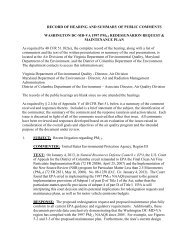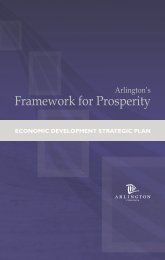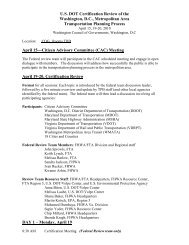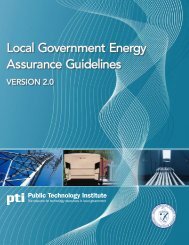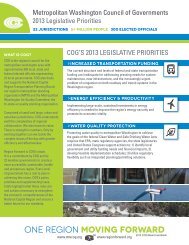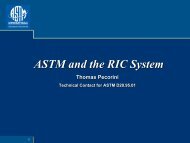Calibration Report for the TPB Travel Forecasting Model, Version ...
Calibration Report for the TPB Travel Forecasting Model, Version ...
Calibration Report for the TPB Travel Forecasting Model, Version ...
Create successful ePaper yourself
Turn your PDF publications into a flip-book with our unique Google optimized e-Paper software.
<strong>Calibration</strong> <strong>Report</strong> <strong>for</strong> <strong>the</strong> <strong>TPB</strong> <strong>Travel</strong> <strong>Forecasting</strong> <strong>Model</strong>, <strong>Version</strong> 2.3<br />
1.5 Special modeling applications<br />
A single standard execution of <strong>the</strong> regional travel is sometimes insufficient <strong>for</strong> representing a special<br />
policy condition that is relevant to a particular <strong>for</strong>ecasted scenario. In recent years, <strong>TPB</strong> staff has<br />
established two model execution “variations,” which address <strong>the</strong> treatment of special transportation<br />
policies or operations.<br />
The first such variation is known as <strong>the</strong> “transit constraint” option. Since <strong>the</strong> year 2000, <strong>TPB</strong> <strong>for</strong>ecasts<br />
have been subject to a Metrorail‐related capacity limitation in <strong>the</strong> core area. It is currently assumed<br />
that, beyond <strong>the</strong> year 2020, all Metrorail trips moving to and through <strong>the</strong> regional core area will not<br />
exceed 2020 levels. Consequently, procedures have been added to all post‐2020 model executions to<br />
compare <strong>the</strong> modeled Metrorail trip table with a pre‐existing 2020 Metrorail trip table. Under current<br />
procedures, post‐2020 Metrorail trips exceeding 2020 ridership levels to and through <strong>the</strong> regional core<br />
are converted into auto trips.<br />
The second variation, known as <strong>the</strong> “HOV‐3+ skims substitution” option, is undertaken to <strong>the</strong> model of<br />
planned HOT (High‐Occupancy/Toll) lanes in Nor<strong>the</strong>rn Virginia. <strong>Model</strong>ing this type of facility has proven<br />
to be especially challenging given:<br />
1. The HOT facility will operate using dynamic tolling, i.e., <strong>the</strong> tolls will change in real time to<br />
maintain a service speed at or near free‐flow levels;<br />
2. The legislative stipulation that SOV’s and 2‐occupant HOVs will pay <strong>for</strong> <strong>the</strong> HOT lane access<br />
while 3+ occupant HOVs will be allowed access to <strong>the</strong> HOT facility at no charge; and<br />
3. <strong>the</strong> legislative stipulation that <strong>the</strong> HOV travel market will suffer no service degradation from <strong>the</strong><br />
HOT lane operation.<br />
Obviously, a central modeling objective in representing HOT lanes is to specify detailed toll rates that<br />
will result in demand levels that do not degrade <strong>the</strong> prevailing speed on <strong>the</strong> HOT facility. Ano<strong>the</strong>r<br />
modeling objective is to ensure that HOV 3+ service levels will remain unaffected by <strong>the</strong> HOT operation.<br />
To achieve <strong>the</strong>se two objectives, <strong>the</strong> following four steps are currently undertaken by <strong>TPB</strong> staff on a<br />
year‐by‐year basis to simulate HOT lanes in Virginia.<br />
1. The travel model is fully executed whereby all Virginia HOT lanes in <strong>the</strong> highway network are<br />
coded as HOV 3+‐priority lanes. The resulting HOV 3+ LOS skim files corresponding to each<br />
iteration (pump‐prime, iteration 1,…, iteration 6) are preserved <strong>for</strong> later use. This step is known<br />
as <strong>the</strong> “base” execution.<br />
2. The travel model is fully executed again. This time, <strong>the</strong> Virgina HOT lanes are coded as mixed<br />
use lanes (i.e., allowing access by both SOVs and HOVs). The HOT lanes are assigned a “straw”<br />
toll level of 20 cents per mile during <strong>the</strong> peak periods and 15 cents per mile during <strong>the</strong> off‐peak.<br />
The toll is included into <strong>the</strong> overall highway impedance during path building in <strong>the</strong> traffic<br />
assignment step. There<strong>for</strong>e, <strong>the</strong> toll level impacts <strong>the</strong> loading in <strong>the</strong> HOT lane facility.<br />
3. The final (iteration 6) highway assignment process (including three traffic assignments <strong>for</strong> each<br />
time period) resulting from Step 2 is run iteratively, on a trial‐and‐error basis, to identify HOT<br />
lane toll rates (cents/mile) which yield optimum speeds on <strong>the</strong> facility. The toll rates are<br />
developed on a freeway segment by segment basis. The queuing delay function is disabled on<br />
<strong>the</strong> HOT lane facility during this particular step as such delay will presumably be minimal given<br />
1‐12



